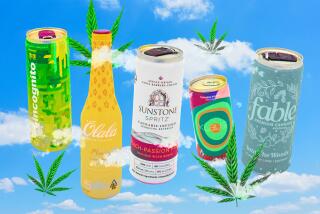Where’s the Juice? Many Fruit Drinks Misrepresented, Study Finds : Marketing: Consumer advocacy group says that apple and grape beverages are frequently passed off as deriving from such exotic sources as kiwi and papaya.
- Share via
WASHINGTON — Consumers spend hundreds of millions of dollars on exotic-sounding fruit drinks, but the papaya juice they think they’re sipping may actually be pineapple.
The Center for Science in the Public Interest reported this week that it had surveyed more than two dozen fruit-juice products and found that the truth about what’s inside the bottle was usually hidden in the fine print.
One label shouted “Very Cherry,” but the small type on the back of the bottle whispered white grape and apple juice. And the main ingredients in the Maine Coast Blueberry juice turned out to be apple juice and apple puree from concentrate, the consumer advocacy group said.
“The food industry is cheating the American consumer out of hundreds of millions of dollars annually by passing off what is mostly apple and grape juice as more expensive kiwi, peach, strawberry and cherry juice,” said Bruce Silverglade, the group’s legal affairs director.
Maine Coast Blueberry sold at one Washington supermarket for $2.39 a quart, compared to a unit price of $1.45 per quart for a half-gallon bottle of Motts pure apple juice.
Silverglade said that because consumers spend more than $9 billion a year on fruit juices and drinks, “people deserve the facts. . . . The name of the juice on the front of the label is not what the consumer is purchasing in many, many cases.”
But John R. Cady, president of the National Food Processors Assn., said that the group’s survey amounted to nothing more than a “disinformation campaign.”
The association and the Center for Science in the Public Interest have also been wrangling over a proposed labeling regulation that would require manufacturers to list the percentage of each juice used in blends.
The Food and Drug Administration must finalize the new labeling requirements by Nov. 8. Juice manufacturers would be required to begin using the new labels by May, 1993.
The processors association contends that listing the percentage of each juice is almost certain to lead to cluttered labels and “info-glut,” said Alan Matthys, the group’s vice president of regulatory affairs.
“If CSPI had its way, food labels would consist of nothing but green lights, red lights, sirens and warnings,” added Cady. “There would be no room for the brand name or picture.”
In addition to the total percentage of juice in the drink, the new labels would also require a full nutritional analysis and a listing of the juices in order of concentration, Matthys said.
“Adding to the label the percentage of each individual juice in the drink will give the consumer no useful additional information or any health or nutritional advantage,” Matthys said. “In fact, it distracts from the key nutritional information.”
Under current labeling regulations, manufacturers must list ingredients in order of predominance but not by percentage.
“Many fruit-juice producers are misrepresenting the composition of products made from two or more juices,” Silverglade said. “The FDA’s proposed labeling regulation, if finalized, would help prevent fruit-juice producers from duping consumers.”
More to Read
Inside the business of entertainment
The Wide Shot brings you news, analysis and insights on everything from streaming wars to production — and what it all means for the future.
You may occasionally receive promotional content from the Los Angeles Times.










